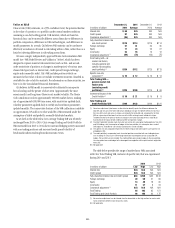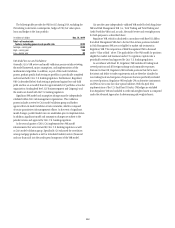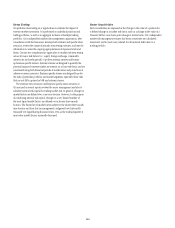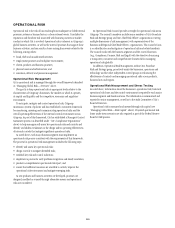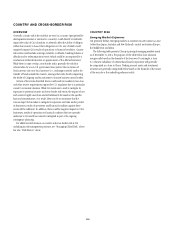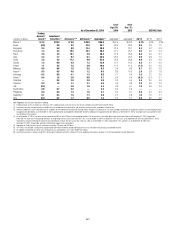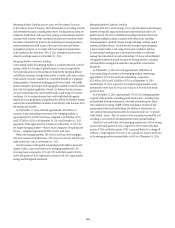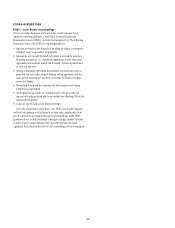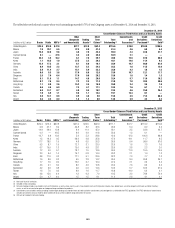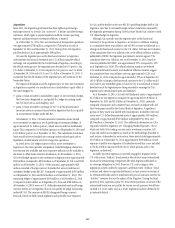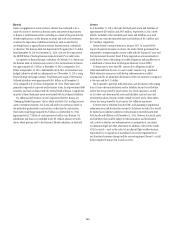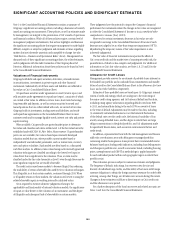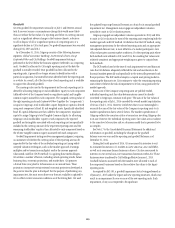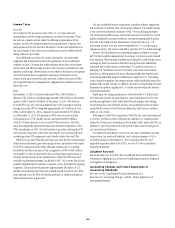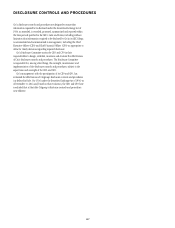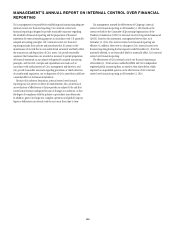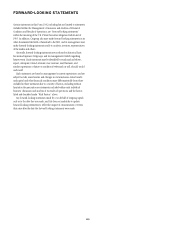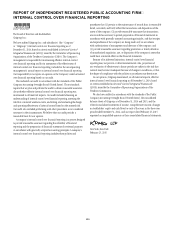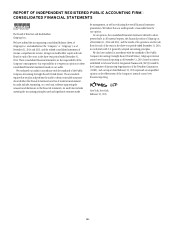Citibank 2014 Annual Report Download - page 138
Download and view the complete annual report
Please find page 138 of the 2014 Citibank annual report below. You can navigate through the pages in the report by either clicking on the pages listed below, or by using the keyword search tool below to find specific information within the annual report.121
Argentina
Since 2011, the Argentine government has been tightening its foreign
exchange controls. As a result, Citi’s access to U.S. dollars and other foreign
currencies, which apply to capital repatriation efforts, certain operating
expenses and discretionary investments offshore, is limited.
As of December 31, 2014, Citi’s net investment in its Argentine operations
was approximately $780 million, compared to $720 million at each of
September 30, 2014 and December 31, 2013. During 2014, Citi Argentina
paid dividends to Citi of approximately $60 million.
Citi uses the Argentine peso as the functional currency in Argentina
and translates its financial statements into U.S. dollars using the official
exchange rate as published by the Central Bank of Argentina. According to
the official exchange rate, the Argentine peso devalued to 8.55 pesos to one
U.S. dollar at December 31, 2014 compared to 8.43 pesos to one U.S. dollar
at September 30, 2014 and 6.52 to one U.S. dollar at December 31, 2013. It
is expected that the devaluation of the Argentine peso will continue for the
foreseeable future.
The impact of devaluations of the Argentine peso on Citi’s net investment
in Argentina is reported as a translation loss in stockholders’ equity offset, to
the extent hedged, by:
• gainsorlossesrecordedinstockholders’equityonnetinvestmenthedges
that have been designated as, and qualify for, hedge accounting under
ASC 815 Derivatives and Hedging; and
• gainsorlossesrecordedinearningsforitsU.S.dollar-denominated
monetary assets or currency futures held in Argentina that do not qualify
as net investment hedges under ASC 815.
At December 31, 2014, Citi had cumulative translation losses related
to its investment in Argentina, net of qualifying net investment hedges, of
approximately $1.51 billion (pretax), which were recorded in stockholders’
equity. This compared to $1.46 billion (pretax) as of September 30, 2014 and
$1.30 billion (pretax) as of December 31, 2013. The cumulative translation
losses would not be reclassified into earnings unless realized upon sale or
liquidation of substantially all of Citi’s Argentine operations.
As noted above, Citi hedges currency risk in its net investment in
Argentina to the extent possible and prudent. Suitable hedging alternatives
have become less available and more expensive and may not be available in
the future to offset future currency devaluation. As of December 31, 2014,
Citi’s total hedges against its net investment in Argentina were approximately
$810 million (compared to $920 million as of September 30, 2014 and $940
million as of December 31, 2013). Of this amount, approximately $420
million consisted of foreign currency forwards that were recorded as net
investment hedges under ASC 815 (compared to approximately $430 million
as of September 30, 2014 and $160 million as of December 31, 2013). The
remaining hedges of approximately $390 million as of December 31, 2014
(compared to $490 million as of September 30, 2014 and $780 million as
of December 31, 2013) were net U.S. dollar-denominated assets and foreign
currency futures in Citi Argentina that do not qualify for hedge accounting
under ASC 815. The increase in ASC 815 designated foreign currency
forwards, which are held outside Argentina and generally more expensive
for Citi, and the decline in the non-ASC 815 qualifying hedges held in Citi
Argentina, were due to increased foreign currency limitations imposed by
the Argentine government during 2014 that have limited Citi’s ability to hold
U.S. dollar hedges in Argentina.
Although Citi currently uses the Argentine peso as the functional
currency for its operations in Argentina, an increase in inflation resulting
in a cumulative three-year inflation rate of 100% or more would result in a
change in the functional currency to the U.S. dollar. Citi bases its evaluation
of the cumulative three-year inflation rate on the official inflation statistics
published by INDEC, the Argentine government’s statistics agency. The
cumulative three-year inflation rate as of December 31, 2014, based on
statistics published by INDEC, was approximately 52% (compared to 50%
as of September 30, 2014). The official inflation statistics are believed
to be underestimated, however, and unofficial inflation statistics suggest
the cumulative three-year inflation rate was approximately 123% as of
December 31, 2014 (compared to approximately 119% as of September 30,
2014). While a change in the functional currency to the U.S. dollar would
not result in any immediate gains or losses to Citi, it would result in future
devaluations of the Argentine peso being recorded in earnings for Citi’s
Argentine peso-denominated assets and liabilities.
As of December 31, 2014, Citi had total third-party assets of approximately
$4.1 billion in Citi Argentina (compared to approximately $3.8 billion at
September 30, 2014 and $3.9 billion at December 31, 2013), primarily
composed of corporate and consumer loans and cash on deposit with and
short-term paper issued by the Central Bank of Argentina. A significant
portion of these assets was funded with local deposits. Included in the total
assets were U.S. dollar-denominated assets of approximately $550 million,
compared to approximately $520 million at September 30, 2014 and
$920 million at December 31, 2013. (For additional information on Citi’s
exposures related to Argentina, see “Emerging Market Exposures” above,
which sets forth Citi’s trading account assets, investment securities, ICG
loans and GCB loans in Argentina, based on the methodology described in
such section. As described in such section, these assets totaled approximately
$3.0 billion as of December 31, 2014. Approximately $190 million of such
exposure is held by non-Argentine Citi subsidiaries and thus is not included
in the $4.1 billion amount set forth above, which pertains only to Citi
Argentina, as disclosed.)
As widely reported, Argentina is currently engaged in litigation in the
U.S. with certain “holdout” bond investors who did not accept restructured
bonds in the restructuring of Argentine debt after Argentina defaulted on
its sovereign obligations in 2001. Based on U.S. court rulings to date,
Argentina has been ordered to negotiate a settlement with “holdout” bond
investors and, absent a negotiated settlement, not pay interest on certain of
its restructured bonds unless it simultaneously pays all amounts owed to the
“holdout” investors that are the subject of the litigation. During the third
quarter of 2014, Argentina’s June 30, 2014 interest payment on certain of the
restructured bonds was not paid by the trustee as such payment would have
violated U.S. court orders and, as a result, Argentina has been deemed to be
in technical default.


